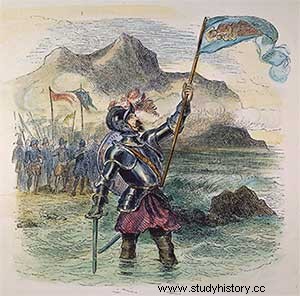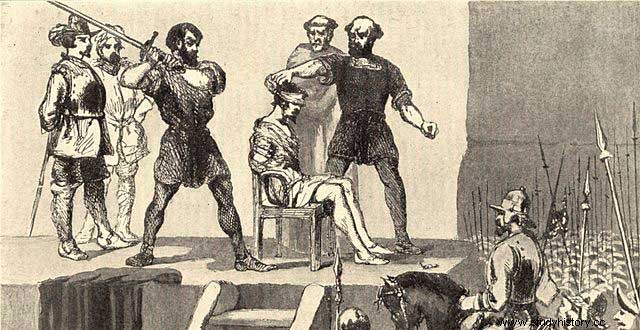Vasco Núñez de Balboa was a Spanish navigator, discoverer of the Pacific Ocean . At the beginning of the 16th century, it was already known that the lands discovered by Columbus were not the Indies, but rather an obstacle to reaching them through the Atlantic. Numerous explorers and adventurers set off in search of the passage that allows them to circumvent the New World or the treasures that it may hide. Vasco Nuñez de Balboa was one of the first to cross the Isthmus of Panama and in 1513 he discovered the Pacific Ocean, which he named the "South Sea". He was also the protagonist and victim of the bitter struggles and intrigues that were waged in those years between advances and Spanish conquerors for the possession of land, titles and possible American wealth.
Data about Vasco Nuñez de Balboa
1475 He was born in Jerez de los Caballeros. 1501 he embarks with Bastidas to the New World.
1510 He founded Santa María de la Antigua, in Darien.
1513 He discovers the Pacific Ocean.
1514 He is named advance of the South, which picks up the name with which he baptized the Pacific.
1517 He dies executed in Acla. (today Panama).
His father was a hidalgo of Galician origin Ñuño Arias de Balboa , scion of a family of lineage come to less. His mother was a lady from Jerez de los Caballeros (Badajoz) , where Vasco Nuñez de Balboa would be born in 1475. After his childhood in Extremadura he was placed as a page in the service of Pedro de Portocarrero, lord of Moguer. In his early youth, he attended the preparations for the Columbian company in the neighboring port of Palos and the subsequent fever of adventures and conquests that disturbed the entire Huelva region. The desire for him must wait until 1501, when the captain Rodrigo de Bastidas (who founded Santa Marta in 1525) accepts him as a crew member on his trip to the New World.

The Bastidas expedition travels the Colombian Caribbean coast , touching the mouth of the Magdalena, the bay of Santa Marta, the Gulf of Urabá or Darién and the Panamanian isthmus. After the Balboa voyage, he remains in Hispaniola (Santo Domingo), where he wins the favor of Viceroy Diego Colón, son of the discoverer. In the already famous conquistador Alonso de Ojeda sets sail to take charge of the new government of Castilla del Oro, to the east of Darién, while his partner Martín Fernández de Enciso prepares to follow him with more men and supplies. Vasco Núñez, who has contracted numerous debts, sneaks into Enciso's ship as a stowaway , fleeing from the creditors of him. He is discovered, but the captain accepts him as pilot, thanks to his previous experience in the waters and coasts towards which they are heading.
Meanwhile, Ojeda, harassed by hostile locals, has returned in search of weapons and reinforcements. Enciso and Balboa find the precarious fort of San Sebastián commanded by Francisco Pizarro, who would later be the —– conqueror of Peru —— . The resistance is desperate and Vasco Núñez —who has gained prestige for his courage and leadership skills— suggests moving to the other shore of the gulf, where the local people are friendlier. Despite Enciso's opposition, many men follow Balboa. In 1510 he founded Santa María de la Antigua in his new location, which would be the first permanent American continental population. That coast does not belong to the government of Ojeda, but to that of Nueva Andalucía, whose governor, Diego de Nicuesa, attacks intruders. Defeated, Nicuesa is abandoned in a boat that capsizes, while Enciso returns to Spain to present his claims on the Darién.
A vast sea to the south
Despite everything, in 1511 Viceroy Columbus obtained the royal appointment as governor of the Darién for Balboa, who gathered in Antigua his old cronies and veterans of other conquests to enter the isthmus of Panama, fighting or negotiating with the natives. He reaches an agreement with Chima, cacique of the caretas, who gives him his daughter as a pledge that Vasco Núñez does not disdain. Later, while interacting with the caciques Ponca and Comogre, he hears stories that speak of "a great sea in the south, which bathes lands of gold." On September 1, 1513 he leads a large expedition of 190 Spaniards and 800 natives , in order to traverse the mountains. After more than three weeks of laborious march, on the 25th he sights the immense ocean, which he calls "South Sea" because that is the direction in which he advances.
The news of the surprising discovery crosses the new governor Pedrarias Dávila, who came to replace him after Enciso's complaints and the accusations of Nicuesa's death, added to the loss of prestige of his protector Diego de Colón. However, given the undeniable importance of his discovery, in 1514 the king appointed him in advance of the South Sea and governor of Panama and Cohiba, although subordinate to Pedradas. Relations between the two governors are very tense and Balboa tries to soften them by accepting a marriage by proxy with a daughter of Dávila who lived in Spain. Determined to explore the shores of the new sea, he repopulates the town of Acia and moves to the shore in order to build several ships, when reports arrive of the imminent arrival of a new governor, Lope de Sosa. Willing to testify in favor of his mother-in-law in the mandatory "residence trial", Vasco Núñez decides to remain in Acia. But Dávila, fearful that Balboa's testimony is intended to the contrary, has him arrested on charges of treason against the crown. Sentenced to death, he is executed in 1517.

